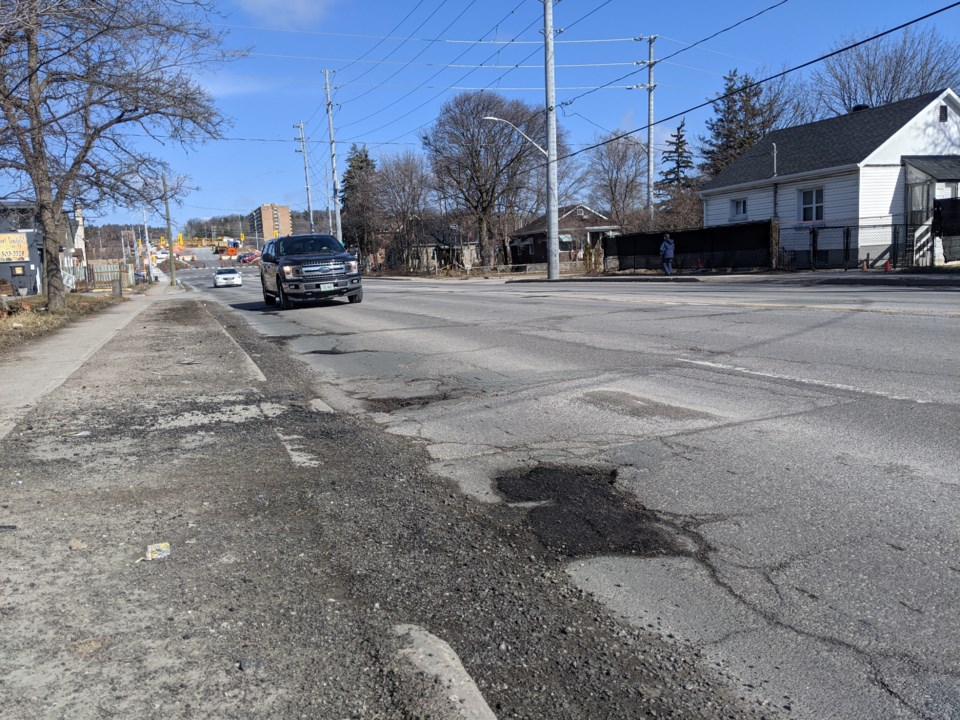Are the bumps in Barrie’s roads getting any better?
Have your say during the 20th annual Canadian Automobile Association (CAA) Worst Roads Campaign, which kicked off today.
“We need to hear from you … your voice matters and we all have a role to play in making our roads safer,” said Teresa Di Felice, assistant vice-president, government and community relations, CAA South Central Ontario.
“Thanks to the voices of tens of thousands of Ontarians, the annual … campaign has been able to influence change,” she added. “Every year, these votes have helped inform various levels of government with an important perspective on what roadway improvements are most important to Ontarians. And where infrastructure funding and investment should be made.”
Kelly Oakley is Barrie’s associate director of corporate asset management. Her department establishes infrastructure standards, and plans for the renewal and growth of infrastructure, including roads.
“While we always pay attention to the CAA Worst Roads list, it usually tells us what we already know,” she said.
“Every four years, the city conducts a condition assessment of all our roads," Oakley added. “Staff maintain that database of the pavement condition, and we use the data to help prioritize which roads to include in the capital (budget) plan.
"Our goal is to optimize spending of tax dollars and road pavement conditions across Barrie.”
During her virtual media conference Tuesday morning, Di Felice rattled off a number of related statistics from a recent CAA survey.
Such as that 78 per cent of respondents vent about the state of roads to their friends, families and loved ones, rather than to local government officials.
That the average cost of repairing pothole damage to vehicles can be $300 to $6,000, and that 85 per cent of Ontarians are paying for the vehicle damage out of pocket and are choosing not to, or are ineligible, to file an insurance claim.
That 59 per cent of Ontarians say the province’s roads have worsened, citing cracks in pavement, potholes and congestion being the top road-related issues.
And that 66 per cent of Ontario drivers are slowing down or swerving to avoid potholes.
“Bad roads continue to impact safety and many drivers are altering their driving behaviours to accommodate for poor road issues,” Di Felice said.
Oakley said the key to keeping Barrie’s roads in good condition is to be proactive.
“The city’s road-resurfacing program targets roads that are just beginning to show signs of deterioration, and replaces the surface with a new layer of asphalt which prevents water from getting into the layers below and further deterioration from occurring,” she said. “We know that for every dollar we invest proactively we can defer more costly investment in full road reconstruction.
“Meaning, it’s more cost effective to target roads before they get to the point that they appear on the CAA’s list.”
Oakley said the city plans its work several years ahead.
“In addition to the road condition, staff consider the needs of the infrastructure below the road, like water mains and sewers, because we want to align the timing of work wherever possible,” she said. “The same consideration is given to whether roads need to be widened to accommodate growth and relieve congestion.”
Barrie has 1,583 kilometres of roads.
Di Felice said nominating worst roads helps decision-makers understand what improvements are important to drivers.
“Since 2003, thousands of roads have been put forward and 114 roads in Ontario have appeared on the provincial top 10 Worst Roads list,” said Di Felice. “Many have had repaving and repair work done.
“The Worst Roads campaign directly impacts infrastructure and helps all levels of government prioritize projects because it provides a window into how their constituents (are thinking).”
Last year, four Barrie streets made it onto the Worst Roads list in the campaign’s central region — Essa Road, Huronia Road, Duckworth Street, and Lockhart Road.
In 2021, it was Huronia near Lockhart, Bell Farm Road (since reconstructed) and Essa near Highway 400, where the overpass/underpass is now being reconstructed and replaced.
The 2022 report on the condition of Barrie’s roads gives them a mixed grade. It says 36 per cent of city streets are in very good shape, 33 per cent are in good condition, 18 per cent are fair, nine per cent are poor, and fouir per cent are considered very poor.
Or that 13 per cent of Barrie's streets are in poor or very poor condition, and that 87 per cent are very good, good or fair.
Barrie’s road renewal capital projects are funded from property taxes, including the dedicated infrastructure renewal fund — designed to fund repairing and replacing roads, pipes and buildings.
A significant amount of the city’s Canada Community-Building Fund, formerly the federal gas tax, is allocated to Barrie’s resurfacing program.
Nominations for 2023 worst roads end April 21. Visit caaworstroads.com to have your say.



